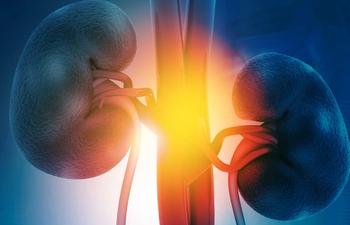
Oncology NEWS International
- Oncology NEWS International Vol 6 No 5
- Volume 6
- Issue 5
Prostate Cancer Guidelines Focus on Risk Categories
FORT LAUDERDALE, Fla--The key feature of prostate cancer that distinguishes it from most other solid tumors is the large discrepancy between annual incidence (about 250,000) and mortality (about 41,000).
FORT LAUDERDALE, Fla--The key feature of prostate cancer that distinguishesit from most other solid tumors is the large discrepancy between annualincidence (about 250,000) and mortality (about 41,000).
"This means that there are many patients who are at risk for overtreatment,and we need to refine the prognostic features that tell us which patientsare going to be in which risk category," said Randy Milliken, MD,in his presentation of the updated prostate cancer guidelines at the 2ndannual meeting of the National Comprehensive Cancer Network (NCCN).
Dr. Milliken, of the M.D. Anderson Cancer Center, was standing in forChristopher Logothetis, MD, chairman of the prostate cancer guidelinescommittee and professor of genitourinary medical oncology at M.D. Anderson.
Coming up with a prognosis that will guide the treatment choice requireslooking at two "biological clocks," he said--that of the cancer(determined by the staging workup) and that of the host (life expectancy).
The consensus view is that after diagnosis (based on PSA, DRE, and Gleasonscore), if life expectancy is less than five years and the patient is asymptomatic,"one should not bother to do a single additional test," Dr. Millikensaid.
Prostate cancers staged as T1A disease are incidental cancers that areneither palpable nor apparent on imaging apparent, and the treatment recommendationis watchful waiting. "But in some cases, even these cancers may beappropriately treated if life expectancy is good and other factors suggestthat the disease may not be biologically indolent," Dr. Milliken said.Such factors include Gleason score greater than 7 and PSA greater than10 ng/mL after transurethral resection.
The bulk of prostate cancers are potentially curable (stage T1 subgroups,stage T2A, B and C). The first task in deciding on treatment in these patientsis to consider the probability that the patient will have organ-confineddisease.
"Approaches based on assessments of probability of cure are goingto become increasingly important as we think about how to steer patientstoward definitive local therapy," Dr. Milliken said.
He cited, for example, the work done at Johns Hopkins by Dr. PatrickWalsh. More than 1,000 consecutive prostatec-tomy patients were stratifiedby preop-erative PSA level, Gleason score, and pathologic stage, and atable was created showing the likelihood of freedom from recurrence afterprostatectomy based on these factors.
Once the probability of organ-confined disease is determined, "thenext question to grapple with is the issue of life expectancy," hesaid. The combination of these two factors will determine treatment (notreatment until symptoms, radiotherapy, or prostatectomy).
In patients with advanced disease, androgen ablation, radiotherapy,or both is recommended, with androgen ablation alone for the most advancedcases.
The exception would be patients with T3A disease, for whom prostatectomymay be considered if they have low volume disease and Gleason score lessthan 7. "Patients with these favorable features may have about a 40%chance of cure with surgery," he said.
For patients who were initially observed and have a limited life expectancy,the guidelines recommend that therapy be withheld and, consequently, thatsurveillance be withheld until the patient has symptoms.
If the initial decision was to observe, but life expectancy is greaterthan 10 years, then the recommendation is to measure PSA twice a year andconsider annual biopsy "because of the well-described tendency forthe Gleason score to change with time," he said.
For patients who had definitive therapy, PSA should be checked twicea year for five years and then annually along with a digital rectal exam."The lead time that PSA gives you in this setting is quite good, atleast seven months or longer," Dr. Milliken said, "and so a PSAevery six months seems to be adequate to preserve the appropriate therapeuticoptions."
For patients who are initially metastatic, surveillance is more extensiveand frequent. "One thing to point out is that antiandrogens do havea certain tendency to upset the liver," he said, "and in patientstaking these drugs, we think that the liver function test should be checkedoccasionally (every month for three antiandrogen cycles)."
For patients with uncharacteristic presentations (visceral disease orlytic bone metastases), biopsy is recommended. "These are red flagsfor a high probability of some histologic variant, such as small-cell carcinoma,for which cytotoxic chemotherapy may, in fact, be the preferred treatment,and it should be given earlier rather than later," Dr. Milliken stressed.
A member of the audience asked why the guidelines for salvage workupcall for a biopsy at the prostate bed in patients who have failed radicalprostatectomy or radiation therapy, even though they have a positive DREand an increase in PSA.
"The main reason is to look for histologic variance," Dr.Milliken answered. "At M.D. Anderson, we've accumulated a large numberof patients with relapsing cancers, especially those that relapse as alarge mass in the pelvis, where the biopsy clearly shows neuroendocrinedifferentiation, and that implies a very different treatment strategy."He added that "the point is well taken that this may not be absolutelynecessary as part of the workup of every such patient."
Primary Salvage Therapy
The guidelines endorse salvage radiotherapy or androgen ablation forpatients who have failed prostatectomy and have negative bone scans, but,conversely, salvage prostatectomy is not recommended for those who havefailed radiotherapy.
"Obviously, there are individual patients for whom salvage prostatectomyis appropriate, but it should never be the first option," Dr. Millikensaid, sparking a member of the audience to suggest that it was not theguidelines' intent to make salvage prostatectomy an option at all, exceptin the case of clinical trials.
Dr. Milliken agreed, reiterating that salvage prostatectomy is not onthe main treatment pathway of the guidelines. "I was trying to makea conciliatory remark because we all have seen patients who are many yearsout, have no detectable disease outside the pelvis, are still young andin good shape, and I think that for some of these patients, a salvage prostatec-tomymakes a certain amount of sense."
In patients with positive bone scans, androgen ablation is the standardof care. "At the top of the list is orchiectomy, which continues tobe the simplest, cheapest, and most definitive way of achieving androgenablation," he said.
If the patient and physician opt for an LHRH agonist, "there isincreasing recognition that this should be coupled with a measurement ofthe serum testosterone a couple of months later," Dr. Milliken said."If serum testosterone is high, then you can either suggest to thepatient that he have an orchiectomy or add an antiandrogen."
At the first sign of rising PSA, the antiandrogen should be withdrawn.Once androgen-independent progression is documented, options for symptomaticpalliation include local radiotherapy, glucocorticoids, or a trial of cytotoxicchemotherapy.
Articles in this issue
over 28 years ago
Delaying Chemotherapy May Compromise Distant Controlover 28 years ago
Precision Dosing a Reality with Intensity Modulated RTover 28 years ago
Breast Cancer Guide on CD-ROM Is Availableover 28 years ago
Mammography's Predictive Value May Be Improvedover 28 years ago
Oncology Administrators Must Plan for Transition in Mergersover 28 years ago
Differentiation Agent Improves Myelodysplasia Survival Ratesover 28 years ago
NCPB Hears From Several Cancer Groups on Policy Issuesover 28 years ago
Guidelines Needed for Distress in Cancer Patientsover 28 years ago
Skin Cancer Project Receives Recognitionover 28 years ago
Few Patients Surveyed Regret Prophylactic MastectomyNewsletter
Stay up to date on recent advances in the multidisciplinary approach to cancer.


















































































